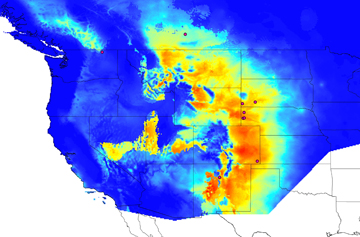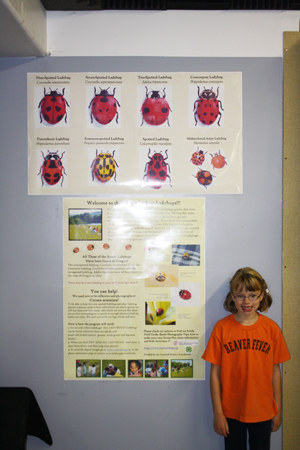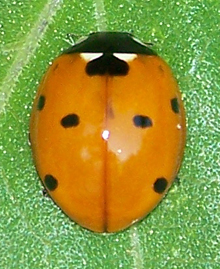Lost Ladybug First Annual Newsletter - June 2010
This is our very first Annual Lost Ladybug Project Newsletter. We would like to give you an update about the success of the program, the patterns we are seeing, and some of the research that is going on at Cornell University. Our newsletter is divided into 6 sections:
Declining Natives Found and Creation of the Lost Ladybug Colonies
Participation
More than 3,000 different people, ranging widely in age and search location, have sent in ladybug photos (up from 1,000 in 2008). If we consider the number of people reached in special programs and presentations the number is far higher. Parallel to the doubling in participation between our first and second years,

Ladybug Spotters at the Akwesasne Nation, bordering New York

Early niche modeling map of Coccinella novemnotata
the number of identified ladybugs has also risen from approximately 2500 to close to 7000. We're still working through several hundred that got tangled in the automated database management transition last year. At least now we can see the light at the end of that tunnel and this years submissions should be processed in a timely fashion.
The Lost Ladybug Project website has now been visited over 100,000 times. Of these, 70% were new website visitors. Ladybug photographs were submitted from all states including the District of Columbia and Puerto Rico, 6 Canadian provinces, and 3 Mexican estados. Participation in Native American communities has included after school, Girl Scout and 4H groups, as well as adults, in the Mohawk, Tuscarora, Cayuga, Onondaga, Oneida, Ojibwe, and Lakota Nations.
Many thanks to all of you who participated in the online survey at the end of last year. The response was high, quite positive, and extremely valuable. A solid portion of survey respondents said their strongest motivation for participating in the program was the desire to contribute to a real scientific study and indicated that the ease of engaging with the LLP facilitated broad interaction and a feeling of authentic contribution. We were also happy to learn that people are really having fun out there doing just what the program needs for them to do! We will use the survey responses to best shape the future of the LLP in terms of where we can streamline and what people would most like for us to offer on the website as it gets developed.
Declining Natives Found and Creation of the Lost Ladybug Colonies
In 2009 many more of the suddenly rare ladybug species were found and each of the three rarest were found in new locations. You can click on the current maps or see them listed by filtering by species names on the LLP Contributors List. As of right now we have 44 ninespotted (Coccinella novemnotata), 53 transverse (Coccinella transversoguttata), and 95 twospotted (Adalia bipunctata), and 24 ththree-banded ladybugs (Coccinella trifasciata). Since we put a lot of effort into targeted searches for some of the rare species where we knew they had been found, these numbers do not correctly describe how very rare these ladybugs are relative to the more common ladybugs that have been submitted to our database. Right now we can compare these numbers to the 2239 of the introduced multicolored Asian ladybugs (Harmonia axyridis) [= 61% of the introduced species, which account for 56% of all the submissions to the LLP] and 844 sevenspotted ladybugs (Coccinella septempunctata) [= another 23% of the introduced species].
With the help of some superspotters we were able to start colonies of several of the suddenly rare native ladybugs: Coccinella novemnotata, Adalia bipunctata, Coccinella trifasciata, and Coccinella transversoguttata, along with the introduced species Coccinella septempunctata.
Two LLP spotters contributed Coccinella novemnotata to the Lost Ladybug colonies. One was then six year old Alyson Yates and her mother, Kate, from Lakeview, Oregon. Early last year they were finding so many rare ladybugs that John Losey and his student Eric Denemark took a trip out to the Oregon Outback (sagebrush desert) to collect with them. You can read John's words about the trip or read about Alyson and Kate in this AP article. John and Eric brought 13 C. novemnotata, 30 C. transversoguttata and more than 40 C. septempunctata back from their trip to Oregon in June 2009.
The C. novemnotata were combined with an equal number from Colorado that were sent to us by another super spotter named Sheena Beaverson. Sheena, a geologist from the Illinois State Geological Survey, was visiting Boulder last June and, in her spare time, started finding an abundance of rare ladybugs along the Chautauqua Park hiking trails. After sending in several photos, she graciously agreed to pack and overnight some live ladybugs to Cornell. Sheena made a presentation about her Lost Ladybug adventures!
 Both Alyson and Sheena have continued to promote the Lost Ladybug Project in their communities as well. Alyson and her mom, Kate, made a Lost Ladybug display for the Lake County Fair last summer. They distributed coloring books and bookmarks at Alyson's school and Kate published an article about their visit with John and Eric for the local newspaper, the Lake County Examiner. Sheena, meanwhile, gave an informal brown bag talk that was open to the Illinois State Geological Survey, where she works, and to the entire Illinois Institute for Resource Sustainability.
Both Alyson and Sheena have continued to promote the Lost Ladybug Project in their communities as well. Alyson and her mom, Kate, made a Lost Ladybug display for the Lake County Fair last summer. They distributed coloring books and bookmarks at Alyson's school and Kate published an article about their visit with John and Eric for the local newspaper, the Lake County Examiner. Sheena, meanwhile, gave an informal brown bag talk that was open to the Illinois State Geological Survey, where she works, and to the entire Illinois Institute for Resource Sustainability.
The LLP twospotted colony began with Adalia bipunctata collected from a small plum tree in Leah and her son, Jack, Tyrrell's yard in Buffalo, New York. They have found more A. bipunctata this year and Leah has been very active giving presentations to many groups in her community to see where else the rare twospotsmay be found nearby.
The Lost Ladybug colonies currently have over 400 adult Coccinella novemnotata, 59 Adalia bipunctata, 25 Coccinella transversoguttata, 24 Coccinella trifasciata, and 10 Coccinella septempunctata. Some of these populations have been kept small while we have actively conducted research with C. novemnotata, but we are now ready to expand again.
More About Research
Documentation of Rare Ladybug Species
Since the spring of 2008 LLP spotters have found more of the once common and now suddenly rare ladybug species than have been found in any other survey in decades. Through May 2010, confirmed sightings include; Coccinella novemnotata [ninespotted] (44), Coccinella transversoguttata [transverse] (53), and Adalia bipunctata [twospotted] (95). While we by no means consider the search to be finished or the current locations where these ladybugs have been found to be the last viable spaces for these native species, we are excited to begin looking for patterns and have enough ladybugs in our colonies to start controlled lab experiments to decipher the causes for their disappearances.
Niche Modeling
We are working with Cornell collaborators to try to understand the importance of habitat in the patterns we see in which C. novemnotata and C. transversoguttata have so far been found mostly in the high dry west, Colorado, South Dakota and the panhandle of Nebraska. In contrast, A. bipunctata has maintained a broader distribution. Niche modeling predicts the likelihood of finding a species based on the climate characteristics of where that species has already been found. An example of a niche modeling map is shown at the top of this page.
Confirmation of Shifts in Ladybug Species Composition
The LLP now possesses one of the largest and most geographically widespread ladybug databases in existence and can confirm the relatively recent shift for ladybugs in North America to at least half introduced foreign species (currently 56%). This is dominated by a single species, Harmonia axyridis (61% of the introduced species).
Documentation of Range Shifts
Spotters with the LPP have found species of ladybugs in areas where they were not previously recorded. A prime example is the first documentation of Harmonia in Arizona (Fothergill et al. 2010, First Arizona records of the multicolored Asian lady beetle, Harmonia axyridis (Pallas) (Coleoptera: Coccinellidae) Coleopterists Bulletin Vol 64 (1) PP 51-52.). We will be keeping track of these trends.
Discovery of Ladybug Pathogens
Native ladybugs in our colonies have been beset with pathogens, such as microsporidia, and these pathogens appear to be novel (in North America) and could have contributed to the decline of native species. The origin of these pathogens and their impact on ladybug populations in the field is under investigation.
Quantification of "Shrinking" Ladybugs
LLP research has determined that the ninespotted ladybugs (C. novemnotata) collected in 2009 were significantly smaller than their offspring reared in the laboratory with constant access to pea aphids. Field collected specimens were also significantly smaller than specimens from the Cornell University Insect Collection that had been collected between 1909 and 1972. Research demonstrated that ninespotted ladybugs that were fed fewer aphids as larvae grew into significantly smaller adults. Many studies have confirmed that smaller individual insects exhibit lower survival and fecundity. These results are consistent with the hypothesis that introduced species, particularly the sevenspotted ladybugs may be outcompeting with the C. novemnotata for food and that this may be contributing to C. novemnotata decline.
Ladybugs with the Wrong Numbers of Spots
 Among the images of sevenspottedladybugs (Coccinella septempunctata) submitted to the LLP are several that show two extra “ghost spots” making them appear more like ninespotted ladybugs (C. novemnotata). In addition, one submitted image has the characteristics of a ninespotted ladybug (e.g. white across the neck shield, black line between the wing covers) except that it has only seven spots. Furthermore, true C. novemnotata and C. septempunctata ladybugs were observed mating in a vial just after collection in 2009. These pieces of evidence have prompted LLP research into the possibility that the closely related ninespotted and sevenspotted ladybugs may be interbreeding.
Among the images of sevenspottedladybugs (Coccinella septempunctata) submitted to the LLP are several that show two extra “ghost spots” making them appear more like ninespotted ladybugs (C. novemnotata). In addition, one submitted image has the characteristics of a ninespotted ladybug (e.g. white across the neck shield, black line between the wing covers) except that it has only seven spots. Furthermore, true C. novemnotata and C. septempunctata ladybugs were observed mating in a vial just after collection in 2009. These pieces of evidence have prompted LLP research into the possibility that the closely related ninespotted and sevenspotted ladybugs may be interbreeding.
Discovery of Ladybug "Washups" in the Fingerlakes
Check out the full story in the News & Notes Archives "archives" !!
A Message About the MATH
You might think, when we boast of documenting nearly 7000 ladybugs, that your work is done. Uh-uh! For the sake of real analysis, it's all about distribution, abundance, and replication .. oh, and "effort." Let's take a look at these.
 Distribution - Basically, we want to cover all the territory. We're putting out a challenge for at least 100 ladybugs from each state (100 spotters would be even better!). Take a look on the right at how many states have contributed less than 50 ladybugs!!!
Distribution - Basically, we want to cover all the territory. We're putting out a challenge for at least 100 ladybugs from each state (100 spotters would be even better!). Take a look on the right at how many states have contributed less than 50 ladybugs!!!
Abundance - Relative abundance means that we need not only to know which ladybugs are out there, but how many of one species there are in relation the other species. Put another way, we cannot say how truly rare the rare species are without comparing them to the numbers of common ones. That's why we keep saying we would like to see EVERY ladybug you find!
Replication - Repeat. Repeat. Repeat. Yes, we would LOVE for you to go back to the places where you have already searched for ladybugs. If you see something once, that's nice. If you see the same thing twice or three times, see how much more solid the information feels? Well, statistically, it really is more solid. The data become more valuable every time you return to the same collecting vicinity.
Effort - The calculation of "effort" requires knowing how many people searched for how long. Here's how it works. For example, if 5 people look for ladybugs for one half hour and find 20, we would expect that the average person in that group would have found 4 ladybugs in the half hour. So then, in a different place or on a different day, if just one person looks for ladybugs for a half hour and finds 20, we'd say there are a lot more (5 times as many) ladybugs than when/where the 5 people were searching. Here is where the ZEROs come in, too. We have designed our submission page to accommodate reports of ladybug searches that don't find ladybugs. It gives us much more information if we know how many people searched for how long and found nothing.
It's easy to see why kids are often the ideal scientists for the Lost Ladybug Project. They have great eyesight. They have stamina. They are excited about every ladybug they find and don't get bored and just start looking for something "different." That said, more than half of the Lost Ladybug Participants (not counting parental supporters) are adults and they've been doing a great job, too!
Next on the Website
The next big addition of content to the LLP website will be the "Ladybug Bios." Over the next few months, each of the species in the LLP database will have its own page. The pages will be linked to the existing Summary Page and will be comprised of taxonomy, representative photos, descriptions, history, links to all the LLP images of that species, a listing of all the current LLP findings of that species, the former (Gordon, 1985) range maps, current LLP range maps, and any other relevant links we know. We think the Ladybug Bios will be informative and fun. They will also provide an easy way to find out more about many of the natives that are always rare. Over 40 of the 79 species currently in the LLP database have been found less than 10 times!
Finally, Our Pitch: Outreach -You Can, Too !!
Please go ahead and help promote the Lost Ladybug Project by making contacts in your communities. We will be more than happy to support you in these efforts! If you are a teacher, or if you know a teacher; if you are a librarian, or if you know a librarian; if you are involved in 4-H or want to have fun at your county fair; if you are an enthusiastic photographer or know someone who needs a new beautiful and small subject; if you can write an article for your local newspaper, or your blog, or your friend's blog…… The possibilities are endless! We will gladly send you bookmarks, posters, printed materials, provide interviews, and support you in any ways we can think of.
THANK YOU SO VERY MUCH !!!!!
Happy Summer
and Happy Beetle Season to You All !!!
